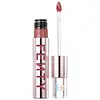What's inside
What's inside
 Key Ingredients
Key Ingredients

No key ingredients
 Benefits
Benefits

No benefits
 Concerns
Concerns

No concerns
 Ingredients Side-by-side
Ingredients Side-by-side

Water
Skin ConditioningGlycerin
HumectantButylene Glycol
HumectantPolysorbate 60
EmulsifyingCeteareth-20
CleansingPhenoxyethanol
PreservativeCaprylyl Glycol
Emollient1,2-Hexanediol
Skin ConditioningPropanediol
SolventIllicium Verum Fruit Extract
PerfumingEthylhexylglycerin
Skin ConditioningPEG-240/Hdi Copolymer Bis-Decyltetradeceth-20 Ether
StabilisingPotassium Laurate
EmulsifyingTocopherol
AntioxidantCI 42090
Cosmetic ColorantCI 17200
Cosmetic ColorantCI 19140
Cosmetic ColorantCI 45410
Cosmetic ColorantMenthoxypropanediol
MaskingPentaerythrityl Tetraisostearate
EmollientDiisostearyl Malate
EmollientDimer Dilinoleyl Dimer Dilinoleate
EmollientPolyglyceryl-10 Decaisostearate
EmollientBis-Behenyl/Isostearyl/Phytosteryl Dimer Dilinoleyl Dimer Dilinoleate
EmollientHydroxyethyl Acrylate/Sodium Acryloyldimethyl Taurate Copolymer
Emulsion StabilisingSqualane
EmollientSorbitan Isostearate
EmulsifyingPolyglyceryl-2 Triisostearate
EmulsifyingCI 77891
Cosmetic ColorantAluminum Hydroxide
EmollientPPG-17/Ipdi/Dmpa Copolymer
Hexylene Glycol
EmulsifyingParfum
MaskingPrunus Salicina Fruit Extract
AntioxidantPrunus Persica Fruit Extract
AbrasiveFragaria Ananassa Fruit Juice
Skin ConditioningPyrus Malus Fruit Extract
Skin ConditioningWater, Glycerin, Butylene Glycol, Polysorbate 60, Ceteareth-20, Phenoxyethanol, Caprylyl Glycol, 1,2-Hexanediol, Propanediol, Illicium Verum Fruit Extract, Ethylhexylglycerin, PEG-240/Hdi Copolymer Bis-Decyltetradeceth-20 Ether, Potassium Laurate, Tocopherol, CI 42090, CI 17200, CI 19140, CI 45410, Menthoxypropanediol, Pentaerythrityl Tetraisostearate, Diisostearyl Malate, Dimer Dilinoleyl Dimer Dilinoleate, Polyglyceryl-10 Decaisostearate, Bis-Behenyl/Isostearyl/Phytosteryl Dimer Dilinoleyl Dimer Dilinoleate, Hydroxyethyl Acrylate/Sodium Acryloyldimethyl Taurate Copolymer, Squalane, Sorbitan Isostearate, Polyglyceryl-2 Triisostearate, CI 77891, Aluminum Hydroxide, PPG-17/Ipdi/Dmpa Copolymer, Hexylene Glycol, Parfum, Prunus Salicina Fruit Extract, Prunus Persica Fruit Extract, Fragaria Ananassa Fruit Juice, Pyrus Malus Fruit Extract
Ingredients Explained
These ingredients are found in both products.
Ingredients higher up in an ingredient list are typically present in a larger amount.
Aluminum Hydroxide is a form of aluminum. It can be naturally found in nature as the mineral gibbsite. In cosmetics, Aluminum Hydroxide is used as a colorant, pH adjuster, and absorbent.
As a colorant, Aluminum Hydroxide may add opacity, or reduce the transparency. Aluminum hydroxide is contains both basic and acidic properties.
According to manufacturers, this ingredient is an emollient and humectant. This means it helps hydrate the skin.
In medicine, this ingredient is used to help relieve heartburn and help heal ulcers.
There is currently no credible scientific evidence linking aluminum hydroxide in cosmetics to increased cancer risk.
Major health organizations allow the use of aluminum hydroxide in personal care products and have not flagged it as a carcinogenic risk at typical usage levels.
Learn more about Aluminum HydroxideCI 19140 is also known as Tartrazine. Tartrazine is a synthetic dye used in cosmetics, foods, and medicine to add a yellow color.
Tartrazine is created from petroleum and is water-soluble.
Some people may experience allergies from this dye, especially asthmatics and those with an aspirin intolerance.
Learn more about CI 19140Ci 77891 is a white pigment from Titanium dioxide. It is naturally found in minerals such as rutile and ilmenite.
It's main function is to add a white color to cosmetics. It can also be mixed with other colors to create different shades.
Ci 77891 is commonly found in sunscreens due to its ability to block UV rays.
Learn more about CI 77891This ingredient is a form of glycerin with emulsifying and emollient properties.
As an emulsifier, this ingredient helps keep products together while adding a thick texture. The manufacturer states this ingredient has emollient properties. Emollients help keep the skin hydrated by trapping moisture in.
Polyglyceryl-2 Triisostearate is created by reacting diglycerin and isostearic acid. Due to the isostearic acid base, it may not be safe for Malassezia or fungal acne.
Learn more about Polyglyceryl-2 Triisostearate